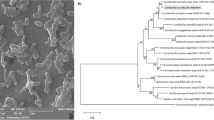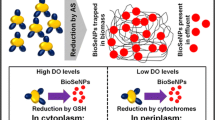Abstract
Simultaneous removal of selenite and tellurite from synthetic wastewater was achieved through microbial reduction in a lab-scale upflow anaerobic sludge blanket reactor operated with 12 h hydraulic retention time at 30 °C and pH 7 for 120 days. Lactate was supplied as electron donor at an organic loading rate of 528 or 880 mg COD L−1 day−1. The reactor was initially fed with a synthetic influent containing 0.05 mM selenite and tellurite each (phase I, day 1–60) and subsequently with 0.1 mM selenite and tellurite each (phase II, day 61–120). At the end of phase I, selenite and tellurite removal efficiencies were 93 and 96%, respectively. The removal percentage dropped to 87 and 81% for selenite and tellurite, respectively, at the beginning of phase II because of the increased influent concentrations. The removal efficiencies of both selenite and tellurite were gradually restored within 20 days and stabilized at ≥ 97% towards the end of the experiment. Powder X-ray diffraction and Raman spectroscopy confirmed the formation of biogenic Se(0), Te(0), and Se(0)–Te(0) nanostructures. Scanning transmission electron microscopy coupled with energy-dispersive X-ray spectroscopy showed aggregates comprising of Se(0), Te(0), and Se–Te nanostructures embedded in a layer of extracellular polymeric substances (EPS). Infrared spectroscopy confirmed the presence of chemical signatures of the EPS which capped the nanoparticle aggregates that had been formed and immobilized in the granular sludge. This study suggests a model for technologies for remediation of effluents containing Se and Te oxyanions coupled with biorecovery of bimetal(loid) nanostructures.







Similar content being viewed by others
References
APHA/AWWA/WEF (2012) Standard methods for the examination of water and wastewater, 22nd ed, Standard Methods. American Public Health Association, American Water Works Association, Water Environment Federation, Washington
Baesman SM, Bullen TD, Dewald J, Zhang D, Curran S, Islam FS, Beveridge TJ, Oremland RS (2007) Formation of tellurium nanocrystals during anaerobic growth of bacteria that use Te oxyanions as respiratory electron acceptors. Appl Environ Microbiol 73(7):2135–2143. https://doi.org/10.1128/AEM.02558-06
Bajaj M, Winter J (2014) Se (IV) triggers faster Te (IV) reduction by soil isolates of heterotrophic aerobic bacteria: formation of extracellular SeTe nanospheres. Microb Cell Factories 13:1–10
Bonificio WD, Clarke DR (2014) Bacterial recovery and recycling of tellurium from tellurium-containing compounds by Pseudoalteromonas sp. EPR3. J Appl Microbiol 117(5):1293–1304. https://doi.org/10.1111/jam.12629
Brown PJ, Forsyth JB (1996) The crystal structure and optical activity of tellurium. Acta Crystallogr A52:408–412
Chasteen TG, Bentley R (2003) Biomethylation of selenium and tellurium. Chem Rev 103(1):1–25. https://doi.org/10.1021/cr010210+
Dessì P, Jain R, Singh S, Seder-Colomina M, van Hullebusch ED, Rene ER, Ahammad SZ, Carucci A, Lens PNL (2016) Effect of temperature on selenium removal from wastewater by UASB reactors. Water Res 94:146–154. https://doi.org/10.1016/j.watres.2016.02.007
Dhillon KS, Dhillon SK (2003) Distribution and management of seleniferous soils. In: Sparks D. (ed) Advances in Agronomy, Academic Press. pp 119–184
Espinosa-Ortiz EJ, Gonzalez-Gil G, Saikaly PE, van Hullebusch ED, Lens PNL (2014) Effects of selenium oxyanions on the white-rot fungus Phanerochaete chrysosporium. Appl Microbiol Biotechnol 99:2405–2418
Espinosa-Ortiz EJ, Rene ER, Guyot F, van Hullebusch ED, Lens PNL (2017) Biomineralization of tellurium and selenium-tellurium nanoparticles by the white-rot fungus Phanerochaete chrysosporium. Int Biodeterior Biodegradation 124:258–266. https://doi.org/10.1016/j.ibiod.2017.05.009
Etezad SM, Khajeh K, Soudi M, Ghazvini PTM, Dabirmanesh B (2009) Evidence on the presence of two distinct enzymes responsible for the reduction of selenate and tellurite in Bacillus sp. STG-83. Enzym Microb Technol 45(1):1–6. https://doi.org/10.1016/j.enzmictec.2009.04.004
Fu S, Cai K, Wu L, Han H (2015) One-step synthesis of high-quality homogenous Te/se alloy nanorods with various morphologies. CrystEngComm 17(17):3243–3250. https://doi.org/10.1039/C4CE02352H
Gates B, Mayers B, Cattle B, Xia Y (2002) Synthesis and characterization of uniform nanowires of trigonal selenium. Adv Funct Mater 12(3):219–227. https://doi.org/10.1002/1616-3028(200203)12:3<219::AID-ADFM219>3.0.CO;2-U
Geick R, Steigmeter EF, Auderset H (1972) Raman effect in selenium-tellurium mixed crystasls. Phys Status Solidi 54(2):623–630. https://doi.org/10.1002/pssb.2220540226
George MW (2003) Selenium and tellurium. In: U.S. geological Suvery minerals yearbook. pp 1–8
Gonzalez-Gil G, Lens PNL, Saikaly PE (2016) Selenite reduction by anaerobic microbial aggregates: microbial community structure, and proteins associated to the produced selenium spheres. Front Microbiol 7:1–14
Gonzalez-Gil G, Seghezzo L, Lettinga G, Kleerebezem R (2001) Kinetics and mass-transfer phenomena in anaerobic granular sludge. Biotechnol Bioeng 73(2):125–134. https://doi.org/10.1002/bit.1044
Hunter WJ (2014) A Rhizobium selenitireducens protein showing selenite reductase activity. Curr Microbiol 68(3):311–316. https://doi.org/10.1007/s00284-013-0474-7
Iovu MS, Kamitsos EI, Varsamis CPE, Boolchand P, Popescu M (2005) Raman spectra of AsxSe100-x and As40Se60 glasses doped with metals. Chalcogenide Lett 2:21–25
Jain R, Jordan N, Weiss S, Foerstendorf H, Heim K, Kacker R, Hubner R, Kramer H, Van Hullebusch ED, Farges F, Lens PNL (2015) Extracellular polymeric substances govern the surface charge of biogenic elemental selenium nanoparticles. Environ Sci Technol 49:1713–1720
Jian X, Yadong L (2003) Solution route to SexTe1−x/Te/SexTe1−x heterojunction nanorods. Mater Chem Phys 82(3):515–519. https://doi.org/10.1016/j.matchemphys.2003.07.002
Jorgenson JD (2002) Selenium and tellurium, In: U.S. geological Suvery minerals yearbook. pp 1–7
Kagami T, Fudemoto A, Fujimoto N, Notaguchi E, Kanzaki M, Kuroda M, Soda S, Yamashita M, Ike M (2012) Isolation and characterization of bacteria capable of reducing tellurium oxyanions to insoluble elemental tellurium for tellurium recovery from wastewater. Waste Biomass Valorization 3:409–418
Kumar MA, Anandapandian KTK, Parthiban K (2011) Production and characterization of exopolysaccharides (EPS) from biofilm forming marine bacterium. Brazilian Arch Biol Technol 54(2):259–265. https://doi.org/10.1590/S1516-89132011000200006
Lenz M, van Hullebusch ED, Hommes G, Corvini PFX, Lens PNL (2008) Selenate removal in methanogenic and sulfate-reducing upflow anaerobic sludge bed reactors. Water Res 42(8-9):2184–2194. https://doi.org/10.1016/j.watres.2007.11.031
Li D-B, Cheng Y-Y, Wu C, Li W-W, Li N, Yang Z-C, Tong Z-H, Yu H-Q (2014) Selenite reduction by Shewanella oneidensis MR-1 is mediated by fumarate reductase in periplasm. Sci Rep 4:3735
Mal J, Nancharaiah YV, Bera S, Maheshwari N, van Hullebusch ED, Lens PNL (2017a) Biosynthesis of CdSe nanoparticles by anaerobic granular sludge. Environ Sci Nano 4(4):824–833. https://doi.org/10.1039/C6EN00623J
Mal J, Nancharaiah YV, van Hullebusch ED, Lens PNL (2016a) Effect of heavy metal co-contaminants on selenite bioreduction by anaerobic granular sludge. Bioresour Technol 206:1–8. https://doi.org/10.1016/j.biortech.2016.01.064
Mal J, Nancharaiah YV, Maheshwari N, van Hullebusch ED, Lens PNL (2017b) Continuous removal and recovery of tellurium in an upflow anaerobic granular sludge bed reactor. J Hazard Mater 327:79–88. https://doi.org/10.1016/j.jhazmat.2016.12.052
Mal J, Nancharaiah YV, van Hullebusch ED, Lens PNL (2016b) Metal chalcogenide quantum dots: biotechnological synthesis and applications. RSC Adv 6(47):41477–41495. https://doi.org/10.1039/C6RA08447H
Mal J, Veneman WJ, Nancharaiah YV, van Hullebusch ED, Peijnenburg WJGM, Vijver MG, Lens PNL (2017c) A comparison of fate and toxicity of selenite, biogenically and chemically synthesized selenium nanoparticles to to zebrafish (Danio rerio) embryogenesis. Nanotoxicology 11(1):87–97. https://doi.org/10.1080/17435390.2016.1275866
Mayers B, Gates B, Yin Y, Xia Y (2001) Large-scale synthesis of monodisperse nanorods of Se/Te alloys through a homogeneous nucleation and solution growth process. Adv Mater 13(18):1380–1384. https://doi.org/10.1002/1521-4095(200109)13:18<1380::AID-ADMA1380>3.0.CO;2-W
Nagata K, Ishibashi K, Miyamoto Y (1981) Raman and infrared spectra of rhombohedral selenium. Jpn J Appl Phys 20:463–469
Nakamaru YM, Altansuvd J (2014) Speciation and bioavailability of selenium and antimony in non-flooded and wetland soils: a review. Chemosphere 111:366–371. https://doi.org/10.1016/j.chemosphere.2014.04.024
Nancharaiah YV, Mohan SV, Lens PNL (2016) Biological and bioelectrochemical recovery of critical and scarce metals. Trends Biotechnol 34(2):137–155. https://doi.org/10.1016/j.tibtech.2015.11.003
Pat-Espadas AM, Field JA, Razo-Flores E, Cervantes FJ, Sierra-Alvarez R (2016) Continuous removal and recovery of palladium in an upflow anaerobic granular sludge bed (UASB) reactor. J Chem Technol Biotechnol 91(4):1183–1189. https://doi.org/10.1002/jctb.4708
Perkins WT (2011) Extreme selenium and tellurium contamination in soils—an eighty year-old industrial legacy surrounding a Ni refinery in the Swansea Valley. Sci Total Environ 412–413:162–169
Prasad KS, Patel H, Patel T, Patel K, Selvaraj K (2013) Biosynthesis of Se nanoparticles and its effect on UV-induced DNA damage. Colloids Surf B Biointerfaces 103:261–266
Rajwade JM, Paknikar KM (2003) Bioreduction of tellurite to elemental tellurium by Pseudomonas mendocina MCM B-180 and its practical application. Hydrometallurgy 71(1-2):243–248. https://doi.org/10.1016/S0304-386X(03)00162-2
Ramos-Ruiz A, Field JA, Wilkening JV, Sierra-Alvarez R (2016) Recovery of elemental tellurium nanoparticles by the reduction of tellurium oxyanions in a methanogenic microbial consortium. Environ Sci Technol 50(3):1492–1500. https://doi.org/10.1021/acs.est.5b04074
Ramos-Ruiz A, Sesma-Martin J, Sierra-Alvarez R, Field JA (2017) Continuous reduction of tellurite to recoverable tellurium nanoparticles using an upflow anaerobic sludge bed (UASB) reactor. Water Res 108:189–196. https://doi.org/10.1016/j.watres.2016.10.074
Ren L, Zhang H, Tan P, Chen Y, Zhang Z, Chang Y, Xu F, Yang F, Yu D (2004) Hexagonal selenium nanowires synthesized via vapor-phase growth. J Phys Chem B 108(15):4627–4630. https://doi.org/10.1021/jp036215n
Spinks SC, Parnell J, Bellis D, Still J (2016) Remobilization and mineralization of selenium-tellurium in metamorphosed red beds: evidence from the Munster Basin, Ireland. Ore Geol Rev 72:114–127. https://doi.org/10.1016/j.oregeorev.2015.07.007
Staicu LC, Ackerson CJ, Cornelis P, Ye L, Berendsen RL, Hunter WJ, Noblitt SD, Henry CS, Cappa JJ, Montenieri RL, Wong AO, Musilova L, Sura-de Jong M, van Hullebusch ED, Lens PNL, Reynolds RJB, Pilon-Smits EAH (2015) Pseudomonas moraviensis subsp. stanleyae, a bacterial endophyte of hyperaccumulator Stanleya pinnata, is capable of efficient selenite reduction to elemental selenium under aerobic conditions. J Appl Microbiol 119(2):400–410. https://doi.org/10.1111/jam.12842
Stams AJM, Grolle KCF, Frijters CTMJ, Van Lier JB (1992) Enrichment of thermophilic propionate-oxidizing bacteria in syntrophy with Methanobacterium thermoautotrophicum or Methanobacterium thermoformicicum. Appl Environ Microbiol 58(1):346–352
Tan LC, Nancharaiah YV, van Hullebusch ED, Lens PNL (2016) Selenium: environmental significance, pollution, and biological treatment technologies. Biotechnol Adv 34(5):886–907. https://doi.org/10.1016/j.biotechadv.2016.05.005
Tang G, Qian Q, Wen X, Chen X, Liu W, Sun M, Yang Z (2015) Reactive molten core fabrication of glass-clad Se0.8Te0.2 semiconductor core optical fibers. Opt Express 23:23624–23633
Tao H, Shan X, Yu D, Liu H, Qin D, Cao Y (2009) Solution grown Se/Te nanowires: nucleation, evolution, and the role of triganol Te seeds. Nanoscale Res Lett 4(9):963–970. https://doi.org/10.1007/s11671-009-9346-2
Turner RJ, Borghese R, Zannoni D (2012) Microbial processing of tellurium as a tool in biotechnology. Biotechnol Adv 30:954–963
Vogel M, Fischer S, Maffert A, Hübner R, Scheinost AC, Franzen C, Steudtner R (2018) Biotransformation and detoxification of selenite by microbial biogenesis of selenium-sulfur nanoparticles. J Haz Mat 344:749–757. https://doi.org/10.1016/j.jhazmat.2017.10.034
Wang Y, Ahmed Z, Feng W, Li C, Song S (2008) Physicochemical properties of exopolysaccharide produced by Lactobacillus kefiranofaciens ZW3 isolated from Tibet kefir. Int J Biol Macromol 43:283–288
Wang Y, Li C, Liu P, Ahmed Z, Xiao P, Bai X (2010) Physical characterization of exopolysaccharide produced by Lactobacillus plantarum KF5 isolated from Tibet kefir. Carbohydr Polym 82(3):895–903. https://doi.org/10.1016/j.carbpol.2010.06.013
Yoon BM, Shim SC, Pyun HC, Lee DS (1990) Hydride generation atomic absorption determination of tellurium species in environmental samples with in situ concentration in a graphite furnace. Anal Sci 6(4):561–566. https://doi.org/10.2116/analsci.6.561
Zhao W, Yang S, Huang Q, Cai P (2015) Bacterial cell surface properties: role of loosely bound extracellular polymeric substances (LB-EPS). Colloids Surfaces B Biointerfaces 128:600–607. https://doi.org/10.1016/j.colsurfb.2015.03.017
Acknowledgements
The authors would like to thank Dr. Chloé Fourdrin (Université Paris-Est Marne-la-Vallée) for the technical help with Raman spectroscopy and P-XRD analysis.
Funding
The authors thank the European Union for providing the financial support through the Erasmus Mundus Joint Doctorate Programme, Environmental Technologies for Contaminated Solids, Soils, and Sediments, grant agreement FPA no. 2010–0009 (ETeCoS3) and the Marie Curie International Incoming Fellowship (MC-IIF) Role of biofilm-matrix components in the extracellular reduction and recovery of chalcogens (BioMatch project no. 103922).
Author information
Authors and Affiliations
Corresponding author
Ethics declarations
This article does not contain any studies with human participants or animals performed by any of the authors.
Conflict of interest
The authors declare that they have no conflict of interest.
Rights and permissions
About this article
Cite this article
Wadgaonkar, S.L., Mal, J., Nancharaiah, Y.V. et al. Formation of Se(0), Te(0), and Se(0)–Te(0) nanostructures during simultaneous bioreduction of selenite and tellurite in a UASB reactor. Appl Microbiol Biotechnol 102, 2899–2911 (2018). https://doi.org/10.1007/s00253-018-8781-3
Received:
Revised:
Accepted:
Published:
Issue Date:
DOI: https://doi.org/10.1007/s00253-018-8781-3




